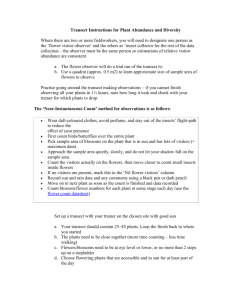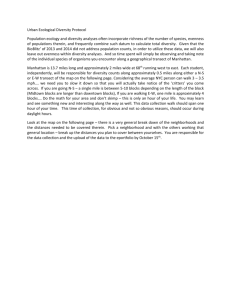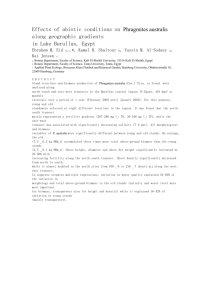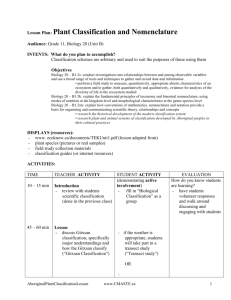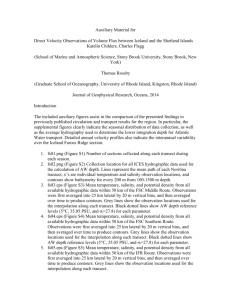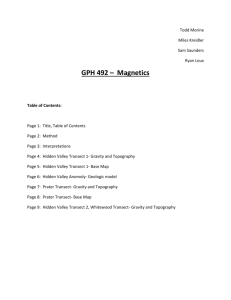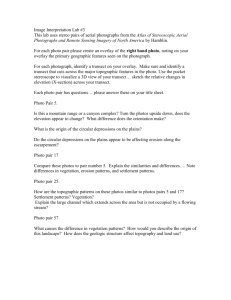supplementary information
advertisement
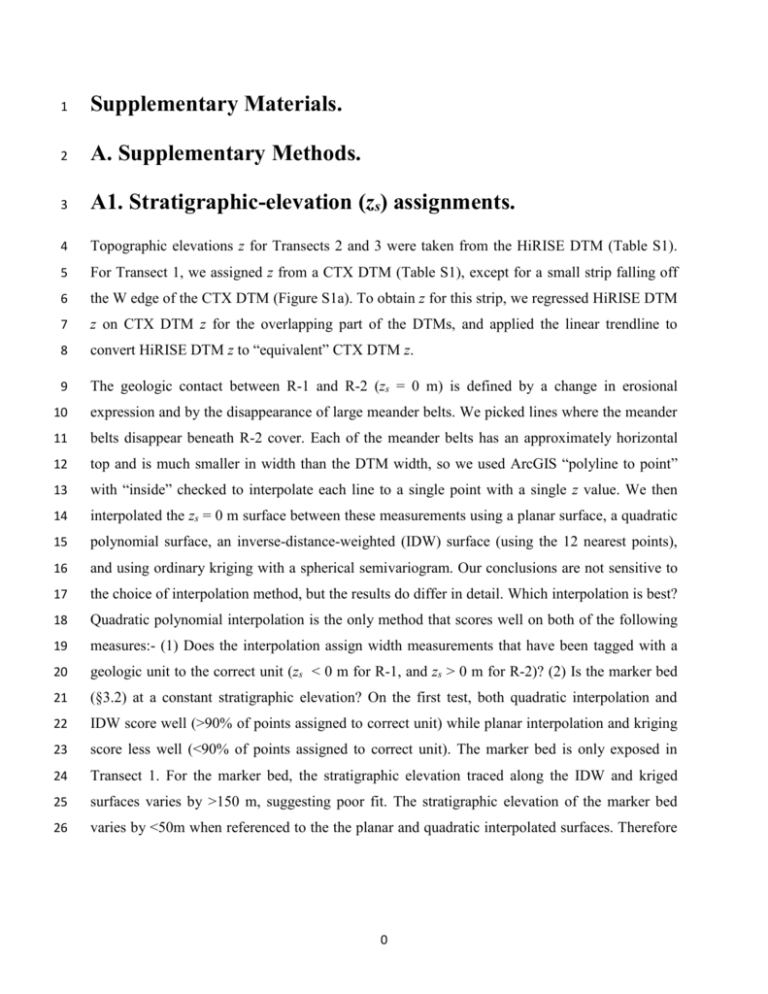
1
Supplementary Materials.
2
A. Supplementary Methods.
3
A1. Stratigraphic-elevation (zs) assignments.
4
Topographic elevations z for Transects 2 and 3 were taken from the HiRISE DTM (Table S1).
5
For Transect 1, we assigned z from a CTX DTM (Table S1), except for a small strip falling off
6
the W edge of the CTX DTM (Figure S1a). To obtain z for this strip, we regressed HiRISE DTM
7
z on CTX DTM z for the overlapping part of the DTMs, and applied the linear trendline to
8
convert HiRISE DTM z to “equivalent” CTX DTM z.
9
The geologic contact between R-1 and R-2 (zs = 0 m) is defined by a change in erosional
10
expression and by the disappearance of large meander belts. We picked lines where the meander
11
belts disappear beneath R-2 cover. Each of the meander belts has an approximately horizontal
12
top and is much smaller in width than the DTM width, so we used ArcGIS “polyline to point”
13
with “inside” checked to interpolate each line to a single point with a single z value. We then
14
interpolated the zs = 0 m surface between these measurements using a planar surface, a quadratic
15
polynomial surface, an inverse-distance-weighted (IDW) surface (using the 12 nearest points),
16
and using ordinary kriging with a spherical semivariogram. Our conclusions are not sensitive to
17
the choice of interpolation method, but the results do differ in detail. Which interpolation is best?
18
Quadratic polynomial interpolation is the only method that scores well on both of the following
19
measures:- (1) Does the interpolation assign width measurements that have been tagged with a
20
geologic unit to the correct unit (zs < 0 m for R-1, and zs > 0 m for R-2)? (2) Is the marker bed
21
(§3.2) at a constant stratigraphic elevation? On the first test, both quadratic interpolation and
22
IDW score well (>90% of points assigned to correct unit) while planar interpolation and kriging
23
score less well (<90% of points assigned to correct unit). The marker bed is only exposed in
24
Transect 1. For the marker bed, the stratigraphic elevation traced along the IDW and kriged
25
surfaces varies by >150 m, suggesting poor fit. The stratigraphic elevation of the marker bed
26
varies by <50m when referenced to the the planar and quadratic interpolated surfaces. Therefore
0
27
we use quadratic interpolation because only the quadratic interpolation does well for both of our
28
tests.1
Transect
1
29
30
Stereopair
DTM resolution (m/pixel)
ESP_017548_1740/ESP_019104_1740
2
ESP_019038_1740/ESP_019882_1740
1
PSP_006683_1740/PSP_010322_1740
1
2
PSP_007474_1745/ESP_024497_1745
2.5
3
PSP_002002_1735/PSP_002279_1735
2
1 (only used for
contact
interpolation)
B20_017548_1739_XI_06S206W/
G02_019104_1740_XI_06S206W
30
Table S1. The HiRISE and CTX DTMs used in this study. All DTMs were produced by A.S.L.,
except for PSP_006683_1740/PSP_010322_1740 which was produced by E.S.K.
31
32
For Transect 3, the R-1/R-2 contact is not exposed, so we extrapolated the contact from regional
33
mapping (Kite et al., submitted). The following approach assumes that the topographic offset
34
between Transect 3 and R-1 corresponds to a stratigraphic offset – for discussion of alternative
35
hypotheses that are consistent with the data, see the main text and Kite et al. (submitted). Over
36
the whole region shown in Fig. 2b, we extracted all MOLA Precision Experimental Data Record
37
(PEDR) points whose center coordinates fell within 150 m of the hand-picked contact (except
38
where the contact was flagged as “inferred”). We chose 150 m because this is ~1/2 the along-
39
track distance between MOLA PEDR laser shots. For these PEDR points, we fitted a planar
40
surface (RMS error 50 m) and a quadratic surface (RMS error 40 m) to the MOLA elevations
41
and extrapolated both surfaces to three locations within Transect 3, finding extrapolated contact-
42
surface elevations of (-2113 ± 35) m (planar) and (-2012 ± 42) m (quadratic). We also picked the
43
10 nearest MOLA PEDR points to Transect 3, finding elevation (-2006 ± 86) m. Equally
1
For Transect 1, the assumption of isotropy underlying our kriging algorithm is troubling
because of preferred wrinkle ridge orientations (obvious in MOLA; see also Lefort et al. 2012).
This is an additional strike against using kriging.
1
44
weighting the three extrapolations (quadratic global, planar global, and same-as-nearest-
45
neighbour) we find (-2044 ± 67) m as the base elevation for Transect 3.
46
Errors in z (intrinsic DTM errors) are small compared to interpolation errors (errors in zs).
47
Interpreting a zs series as a relative-time series is only valid if the river deposits are eroding out of the
48
rock (rather than being late-stage unconformable cut-and-fill imprinted on near-modern topography,
49
as at Gale crater; Milliken et al. 2014). Kite et al. (submitted) show that the Aeolis Dorsa river
50
deposits are eroding out of the rock. A second requirement is that the amplitude of incised valleys
51
(cut-and-fill cycles) must be smaller than the scale of data interpretation. Very-large scale incised
52
valleys can be ruled out in southern Aeolis Dorsa (Kite et al., submitted), but it is possible that the R-
53
1/R-2 contact is somewhat time-transgressive.
54
A common pattern for river-deposit erosional expression in S Aeolis Dorsa is that a plug of sediment
55
is exposed as an inverted channel at higher elevations, which can be traced downslope into double
56
ridges, and then traced further downslope into negative relief (widening channel) preservation.
57
Similar forms of preservation (double ridge, negative relief) are observed at Aeolis Serpens, slightly
58
north of our study area (Williams et al. 2013). This can be interpreted in terms of wind erosion first
59
exhuming, and then progressively obliterating, a channel-filling sediment plug (Farley et al. 2014).
60
This supports our inference that the channel deposits are embedded in stratigraphy.
61
The outcrop-scale observation that at least some meandering channel systems were aggradational
62
(Fig. 1, Fig. 6) gives confidence that the observed inverted channels are channel deposits. Fluvial
63
sedimentary bedforms would confirm this interpretation, but were not observed in the orbital imagery
64
of these transects. It is possible that some streams were generally incising but interrupted by aeolian
65
deposition that fossilized the channels (such that some channel-filling sediment plugs are aeolian
66
materials and not fluvially transported).
67
We do not know if the transition seen in Fig. 4 spans the main great drying of Mars or is a brief
68
window into a complicated climate evolution. Evidence for return to wetter conditions high in the
69
stratigraphy favors the latter. Wind or river erosion may have obliterated the sedimentary record of
70
additional, unseen river episodes. There may be an unconformity between R-1 and R-2 (Kite et al.,
71
submitted). Correlation between late-stage river events is in its infancy (Ehlmann et al. 2011).
2
-2
1
0
-2075
3
0
2
-5
-2150
-2325
-2375
ESP_017548_1740/ESP_019104_1740
-22
50
-2350
-2150
a)
-22
00
75
-21
-2200
25
-21
50
-21
-27
5
-2400
5
-2
-2200
-2
1
5
-2
1
0
-2200
-2400
-2050
0
-210
74
00
-23
ESP_019038_1740/ESP_019882_1740
-2225
-215
0
-2175
PSP_006683_1740/PSP_010322_1740
72
A2. Paleohydrologic-proxy measurements and locations.
73
-2
-22
75
-222
5
-22
00
-20
-2175
-2200
-222
5
-2
-2125
-2000
-2250
-2250
-2225
PSP_007474_1745/ESP_024497_1745
-2250
75
b)
4
76
c)
5
Figure S1. Transect-by-transect locator maps showing all measurements. a) Transect 1 (gray
contours at 25m intervals from CTX DTM; gray shaded area shows area above the interpolated
R-1/R-2 contact); b) Transect 2 (gray contours at 50m intervals from HiRISE DTM; gray
shaded area shows area above the interpolated R-1/R-2 contact); c) Transect 3 (gray contours at
25m intervals from HiRISE DTM). For all transects, thin lines correspond to channel threads.
Thick colored lines show measured channel segments (centerlines for λ and bank-pairs for w),
as follows:- Dark blue: R-1, w. Light blue: R-2, w. Pink: Transect 3, w. Black: R-1, λ. Red: R-1,
λ. Green: Transect 3, λ. Orange shows λ and w measurements very close to the R-1/R-2 contact
that were not assigned to a unit.
77
78
We systematically surveyed our DTMs for paleohydraulic proxies. Survey boxes were defined
79
such that each pixel on the screen corresponded to 1.5 pixels on the orthorectified image. Each
80
survey box was inspected in turn. Channels are preserved in both negative relief (as valleys) and
81
as inverted channels. For the three independent channel-centerline picks, the view was repicked
82
3 times and rotated by 90° between each pick. The stretches on both the DTM (rainbow color
83
scale) and the orthophoto (grayscale) were set to 2 standard deviations. Complete blinding is not
84
possible because the human operator can generally tell (from the erosional expression of the river
85
deposits) what part of the stratigraphic column they are working in. However, because almost all
86
channel picks were done at a zoom level where the margins of the ‘boxes’ were not visible, the
87
human operator is usually blind to the absolute scale of the features being picked.
88
In order to measure w and λ as objectively as possible, we extract w and λ semi-automatically.
89
The remaining subjective step is the initial selection of channel-centerlines and bank-pairs for
90
tracing, and the assignment of a quality score to each (low-quality “candidate” data are excluded
91
from the fit). The HiRISE DTMs were valuable for this step because they allow us to identify
92
places where channels appeared to be continuous in plan-view HiRISE images, but had large
93
stratigraphic offsets. We used terrestrial compilations to determine the range of acceptable along-
94
channel stratigraphic offsets (Gibling 2006).
95
6
96
97
The following attributes were assigned for every bank-pair:
Table S2. Attributes recorded for bank pairs (subsequently processed to extract w).
Attribute
Description
Values (summed for hybrid/combined/intermediate values)
DoubRidges
Are double
ridges
present?
1 – Yes, double ridges (sensu Williams et al. 2013) are present for this
segment of channel (not necessarily the section of bank measured).
-1 – No, double ridges are absent.
PQuality
Preservation
quality
PStyle
Preservation
style
DefnBank
How is
measured
bank
defined?
IsSinuous
Is bank-pair
measured on
a sinuous
channel?
1 – Gold standard. Unusually unambiguous (e.g., paired ridges on
banks measured and an inverted channel (topo & ortho).
2 – Good (can be topo or ortho)
4 – Probable.
8 – Candidate. Do not use, but retain for later review.
1 – Valley (negative relief).
2 – Part of clear meander / sinuous shape (visible lateral-accretion
deposits not necessary)
4 – Negative-relief valley containing positive relief deposit.
8 – Inverted channel.
16 – Double ridges only.
1 – Break-in-slope picked using illumination on orthorectified image.
2 – DTM-picked break-in-slope.
4 – Ortho inner channel (e.g. PStyle = 3) or ortho bank indicators (e.g.
double ridges or abrupt end of lateral-accretion deposits).
8 – Multiple DTM picks on break-in-slope or trace on curvature raster
(from DTM).
16 – Same elevation as break-in-slope on paired bank.
1 – Definitely has channel-like sinuosity.
0 – Unclear or ambiguous evidence for channel like sinuosity.
-1 – No meaningful evidence for channel-like sinuosity.
TieNumber
UnitAssign
BankCode
Geologic
unit hosting
measured
bank-pairs
Unique integer joining non-independent bank-pairs (which are
resampled together in the bootstrap).
1 – R-1
2 – R-2
-9 – Uncertain.
Unique integer for pairs of nearby banks in otherwise confusing terrain.
98
99
7
100
101
102
The following attributes were recorded for channel centerlines:
Table S3. Attributes recorded for channel centerlines (subsequently processed for λ measurements).
Attribute
PQuality
Description
Preservation
quality
PStyle
Preservation
style
TrAmbig
Trace
ambiguity
TrQual
Trace
quality
UnitAssign
Geologic
unit hosting
measured
bank-pairs
SureMeander
TieNumber
Values (summed for hybrid/combined/intermediate values)
1 – Gold standard. Unusually unambiguous (e.g., paired ridges on
banks measured and an inverted channel (topo & ortho).
2 – Good (can be topo or ortho)
4 – Probable.
8 – Candidate. Do not use, but retain for later review.
1 – Valley (negative relief).
2 – Part of clear meander / sinuous shape (visible lateral-accretion
deposits not necessary)
4 – Negative-relief valley containing positive relief deposit.
8 – Inverted channel.
16 – Double ridges only.
In areas of complex preservation:
1 – No significant ambiguity in channel trace.
2 – Single thread, but significant stratigraphic ambiguity.
4 – Single channel, but confusion due to switch between preservation
styles (or similar).
8 – Ambiguity between multiple channels or meanders on a single
“level” of preservation.
16 – Ambiguity between multiple levels (distinct threads per channel).
Level of “worry” associated with effect of TrAmbig on integrity of
meander λ measurements. (Analogous to PQuality in Table S2).
1 – λ very unlikely significantly affected.
2 – λ possibly corrupted at <30% level.
4 – λ possibly corrupted at >30% level.
8 – λ corruption is likely (do not use, but retain for later review).
1 – R-1.
2 – R-2.
-9 – Uncertain.
1 – Measurements definitely pertain to one or more meanders.
-1 – Measurements do not definitely pertain to one or more meanders.
Unique integer joining non-independent channel centerlines (which are
resampled together in the bootstrap).
103
We also picked polygons outlining areas of channel deposits and evidence for channel migration
104
during aggradation.
105
8
106
107
A3. Data reduction - extraction of wavelength (λ) and width (w).
a)
b)
9
Figure S2: Zoom in to the data figures shown in Figure 4, emphasizing the stratigraphy spanning
the R-1/R-2 contact (zs = 0 m). Symbols correspond to transects with crosses × for Transect 1,
and circles ○ for Transect 2.
108
109
Our data reduction is carried using MATLAB scripts. Paleohydrologic-proxy line picks (bank
110
pairs
111
parseMeanderWavelengthMeasurementsMarsRivers
112
parseWidthMeasurementsMarsRivers. Similarly, area picks are converted to fractional
113
areas versus stratigraphic elevation using parseAuxiliaryDataMarsRivers. We do not
114
correct for the fractal dimension of the features being measured, because most of the river
115
channels are parts of networks that have a lateral extent much greater than that of the features
116
being measured (and usually larger than the length of our transects).
and
channel
centerlines)
are
converted
to
w
and
λ
using
and
117
118
Wavelength (λ) extraction
119
(parseMeanderWavelengthMeasurementsMarsRivers.m) : -
120
This script is heavily influenced by Howard & Hemberger (1991). Channel-centerline picks are
121
ingested from ArcGIS-exported shapefiles. Candidate (low quality) data are then deleted, and
122
points are interpolated uniformly along the channel-centerline polyline traces. The distance
123
between interpolated points is 10 m. The polylines are then converted to coordinates of { s, θ },
124
where s is distance along the channel and θ is along-channel direction. Curvature ∂2θ / ∂2s is
125
then calculated for each interpolated point on the channel, and is smoothed using a 10-point
126
moving baseline. Every point where the curvature changes sign is tagged as a candidate
127
inflection point. Trial half-meanders are defined as the segment of channel between these
128
candidate inflection points. The sinuosity ξ for each trial half-meander is defined as the ratio of
129
along-channel distance between inflection points to the straight-line distance between inflection
130
points. Only half-meanders with ξ ≥ 1.1 are used. If any candidate inflection point is the end-
131
points for two half-meanders with ξ < 1.1, then that candidate inflection point is removed and the
132
trial half-meanders are re-calculated.
133
A real half-meander should be identifiable in repeated picks of the same channel. Therefore, we
134
compare the three picks of each meandering channel to seek half-meanders that are reproduced
10
135
on multiple picks. We define reproducibility as requiring that the median distance between points
136
dotted uniformly along the straight lines defining half-meanders be less than ¼ of the straight-
137
line length of the half-meanders. The error assigned to the replicable half-meander is then the
138
standard deviation of the straight-line lengths of the reproduced half-meanders on each trace.
139
Finally, some centerline traces contain multiple replicable half-meanders. Because our centerline
140
traces are fairly short, meander wavelengths on the same centerline trace are not independent. (If
141
we artificially altered the wavelength of an upstream-most half-meander on one of our centerline
142
traces, then the flow pattern for the downstream half-meanders would be greatly affected).
143
Therefore, we combine the (log-)mean of half-meander wavelengths measured on the same
144
centerline trace. Error bars are also combined assuming a log-Gaussian distribution of errors.
145
Width (w) extraction (parseWidthMeasurementsMarsRivers.m) : -
146
Bank-pair picks are ingested from ArcGIS-exported shapefiles. Points are dotted uniformly along
147
each bank. The distance between dots is 2.5m. For each dot, the closest distance to any point on
148
the polyline of the opposite bank is found. (If the closest point is at the end of the bank trace, that
149
width measurement is excluded). The mean of these closest distances for the bank-pair is the
150
channel width, and the standard deviation of these closest distances is the error. Bank-pairs
151
measured on the same channel are aggregated, assuming Gaussian errors.
152
Auxiliary data extraction (parseAuxiliaryDataMarsRivers.m) : -
153
Polygons outlining areas of channel deposits and evidence for channel migration during
154
aggradation are ingested from ArcGIS. Raster grids of DTM topography and grids of
155
interpolated stratigraphic surfaces are also ingested from ArcGIS. zs is set for every point on the
156
grid by subtracting the interpolated stratigraphic surfaces from the topography. Channel
157
polygons are divided into small triangles using Delauney triangulation. The area of each small
158
triangle is calculated. The stratigraphic elevation of the vertices of each small triangle is obtained
159
from the zs grid. The zs of each small triangle is assumed to be the mean zs of the vertices of that
160
triangle. The area of the small triangle is then added to the total area for that stratigraphic-
161
elevation bin. Finally, the total areas for each bin are divided by the exposed outcrop areas (for
162
the entire DTM), found from the raster grids. zs errors are not taken into account for auxiliary
163
data.
11
164
B. Transect-by-transect stratigraphic logs.
165
a)
166
b)
12
167
c)
168
169
170
Figure S3. λ versus zs. Color corresponds to sinuosity ξ. a) Transect 1; b) Transect 2; c) Transect
3. The stratigraphic RMS error is 20 m for Transect 1; 5 m for Transect 2; and 67 m for Transect
3.
171
a)
13
172
b)
173
c)
174
175
Figure S4. ξ versus zs. a) Transect 1; b) Transect 2; c) Transect 3. The stratigraphic RMS error is
20 m for Transect 1; 5 m for Transect 2; and 67 m for Transect 3.
14
176
a)
177
b)
15
178
c)
179
180
181
Figure S5. w versus zs (with w collated by TieNumber). a) Transect 1; b) Transect 2; c) Transect
3. The stratigraphic RMS error is 20 m for Transect 1; 5 m for Transect 2; and 67 m for Transect
3.
182
a)
16
183
b)
184
c)
185
186
187
188
189
190
Figure S6. w versus zs (individual w bank-pair measurements). Colors correspond to
preservation style:- dark blue (PStyle=1) for valleys (negative relief), light blue (PStyle=2) for
part of clear meander/sinuous shape, green (PStyle=4) for negative-relief valleys containing a
positive-relief deposit, orange (PStyle=8) for inverted channels, and red (PStyle=16) for double
ridges only. a) Transect 1; b) Transect 2; c) Transect 3. The stratigraphic RMS error is 20 m for
Transect 1; 5 m for Transect 2; and 67 m for Transect 3.
17
191
a)
192
193
b)
194
195
Figure S7. Results of crosscheck for cases where width and wavelength measurements were
collocated. “Criterion for paleodischarge” is from Burr et al. (2010). a) Transect 1; b) Transect 2.
18
